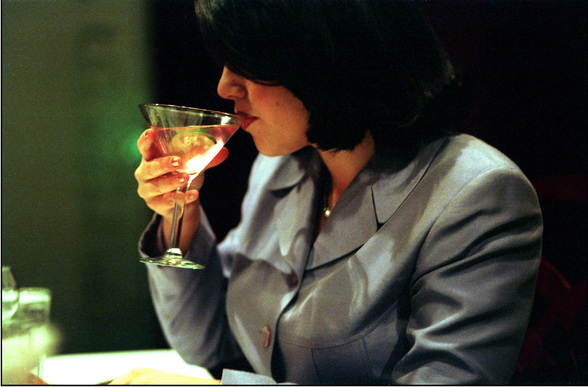
I first heard the news of the presidential affair in a small luncheonette in West Virginia, as I was driving home from an assignment to photograph the new government computer center in Senator Robert C. Byrd’s backyard. The news on the radio (this was before the Web had upended news cycles, and everything else) was not promising for Bill Clinton. A young woman was said to have had an affair in the Oval Office with the president. It set off a wild period of Washington street photography. Dozens of photographers were staked out all over the city, waiting for a moment that the young woman in question, Monica Lewinsky, might hop into or out of her coach, a big SUV. After a few days of the chase–and frankly not one interesting photograph–I got a call from Michele Stephenson, Time magazine’s photo editor. “Are you free Saturday evening?” she asked.
And thus began the intricate, and somewhat awkward, saga of making the first set of pictures of Lewinsky that were not centered around her alighting from an SUV. I was to team up with Time‘s DC bureau chief Michael Duffy, and at 6pm Saturday evening we would meet with Lewinsky and her lawyers at Morton’s, the trendy steakhouse on Connecticut Avenue. Michael and I got there about 6 and huddled in a corner of the bar, sipping ginger ale and waiting for our subjects to arrive. As it happened we each had people coming to our houses for dinner, and were both worried, though not greatly, that Lewinsky would find us so charming that she would invite us to stay for dinner.
About 6:30 we saw a flash of police lights in front of the restaurant, and a minute later Lewinsky and her entourage walked through the darkened hallway to a small, private room. I’d been advised to bring just one camera, no flash, and be very low key. Well, of course, as a professional I brought what I needed: two cameras and one flash. But I was pretty low key. We walked into the private dining room, and everyone was introduced. Time had agreed to certain ground rules — because of the legal issues, no direct questions about the president. The assignment was to find out who this young woman was. The conversation was very easygoing.
“You don’t mind if I shoot a few snaps?” I asked, and everyone nodded okay. It was a dark-paneled room with spotty overhead lights, a real challenge to shoot. A few minutes into the session, Lewinsky picked up her cosmo in a sleek martini glass, and started to take a sip. Her hair cascaded down over her eyes, and for one brief moment all I could see was the glass, her lips, and the outline of her face. To me, that was the picture, the mysterious picture of the mystery woman.
The atmosphere was quite upbeat, although Lewinsky did complain about how her life had all of a sudden become so untenable, and her inability to go out in public was a rather large inconvenience. Perhaps the most astonishing thing about our interview was the realization that for Lewinsky, the most important thing about the scandal was what it had done to her. It was as if she didn’t understand, or care, that the fate of the most powerful person in the world was in her hands. You could chalk it up to the narcissism of youth–Lewinsky was 24 at the time–but it still had an otherworldly quality. I wondered if I was living in the same country, at the same time and place, as she.
After a long half hour, it was clear our time was drawing to a close. Michael and I said our goodbyes and headed to our respective homes, where our friends talked about little beyond the scandal. The two of us remained dutifully silent about our whereabouts earlier that evening.
Over the next few months the pictures I took that night were used here and there in the ongoing Lewinsky story. But it wasn’t until the end of the year that Life magazine actually ran my “cosmo” picture. My favorite shot, as is often the case, had a tough time finding a home. Once published, though, it became the picture. Sometimes an image just has to be seen to make something real out of it.
David Burnett has photographed every US president since John F. Kennedy. He is a co-founder of the photo agency Contact Press Images.
